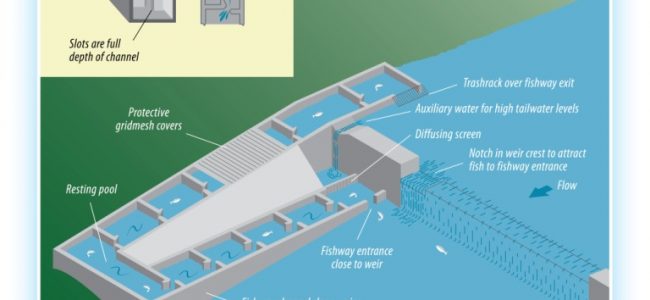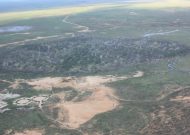
Background
There are nine native fish species that call the Lachlan River home. Many of these fish species migrate short and long distances to spawn, feed and seek shelter. Structures such as dams, weirs, regulators and poorly designed road crossings can create physical barriers that prevent fish movement up and down the river, and stop them from accessing breeding habitat and establishing new territories. A drop of just 10 cm can be a barrier to some species of native fish.
To ensure the long-term survival of native fish communities in the Lachlan, it is essential that fish can negotiate their way past man-made structures. To date, there have been four fishways constructed by State Water Corporation (SWC) in the Lachlan Catchment: located at Island Creek Weir, Bumbuggan Weir, Lake Cargelligo Weir and Booligal Weir. While fishways come in many forms (e.g. Denil, vertical-slot, lock) and are specifically designed for each location, the vertical slot design in Figure 1 is common in the Lachlan.
Method
In order to assess the effectiveness and functionality of fishways, monitoring utilises Passive Integrated Transponder (PIT) tags inserted into large-bodied fish captured during electrofishing surveys downstream of the weirs (Figure 2). The fish, which are inserted with PIT tags (similar technology to a microchip that is implanted in domestic pet animals), are then released to undertake normal migrations. As PIT-tagged fish enter and exit a fishway fitted with a reader device, they are scanned to identify and archive the species and size of fish that are successfully using the fishway.
PIT tags allow researchers to remotely evaluate the effectiveness of fishways in passing target species and size classes, while also providing insights into migrational timing associated with river flows, seasons, and weir operation. Information that can be analysed via PIT tags include the percent of tagged fish that approach the fishway, percent success of fish that enter versus exit the fishway, and the time taken for individual fish to move through the fishway (ascent time).
Preliminary Results
To date, over 1700 fish have been PIT tagged in the Lachlan River, 85% of which were Carp. Murray Cod make up 9% and Golden Perch 5%, with the remaining 1% being Eel-tailed Catfish and Silver Perch.
Unsurprisingly, preliminary data from Island Creek and Bumbuggan fishways indicate that Carp are fearless, strong swimmers and quick learners, with the majority of them zooming through the fishways and successfully exiting upstream. Typically, they were recorded as approaching the entry point of the fishway a couple of times before actually entering. The ascent time, which is the time taken for a fish to move all the way through the fishway, varied between the different fishways. However, Carp outperformed every other species in terms of getting up the courage to enter and the speed in which they were able to negotiate the fishway, which for the most part was less than few hours.
On the other hand, Murray Cod and other native species were recorded as typically approaching a fishway anywhere from four to nine times before entering, in timeframes ranging from just over 1 hour to 4 days or more. Ascent time also varied greatly between sites and species, taking anywhere between 1 and 25 hours for them to successfully move through the fishways. With the installation of a new PIT tag reader at Booligal and the repair of the reader at Lake Cargelligo (which was flooded and offline), more data is set to flow in to give us all an insight into the secret life of fish.


